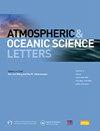京津冀地区5年重现期极端高温事件通用热气候指数时空特征
IF 3.2
4区 地球科学
Q3 METEOROLOGY & ATMOSPHERIC SCIENCES
引用次数: 0
摘要
全球变暖加剧了极端高温事件的频繁发生,对人类健康构成了重大威胁。然而,在这种区域极端情况下,人类热舒适的动态变化仍未得到充分研究。利用40年174个台站的气象资料,研究了中国京津冀地区5年回归期极端高温事件的通用热气候指数(UTCI)时空特征。通过赤池信息准则,选取了16个区域极端热事件,确定了具有位置参数链接函数的非平稳广义极值分布模型为最优模型(适用于65.3%的站点)。结果表明:极端高温阈值随回归期的增加而升高,最高阈值集中在北京和石家庄附近;气温和平均辐射温度是影响UTCI的主要因素,其中白天气温对UTCI的贡献率为47.03% ~ 50.64%,夜间平均辐射温度对UTCI的贡献率高达48.55%。在空间上,UTCI定义的“极端热应激”条件主要出现在北京东南部平原和河北省南部。在北京时间1200 - 1600 BT之间,UTCI达到峰值,在0000 - 0600 BT之间,大部分地区普遍恢复到“无热应激”水平。这些发现为研究北京地区极端高温事件期间人类热舒适的动态提供了重要见解,为制定有针对性的热缓解和适应策略提供了有价值的科学支持。摘要本研究旨在探讨京津冀地区五年一遇极端高温事件期间通用热气候指数的时空特征, 弥补极端高温条件下人类热舒适度动态变化研究的不足. 基于174年站点数据,采用非平稳广义极值(GEV)分布模型,通过赤池信息准则选取最优模型,识别出16次极端高温事件。结果表明, 极端高温阈值随重现期延长而升高, 北京, 石家庄周边最高. 气温和平均辐射温度是UTCI主导因素,极端高温热应力主要分布于北京东南部平原及河北南部,UTCI在12至16时达峰值,00至06时降至“无热应力”水平。本研究为高温应对提供了科学支撑.本文章由计算机程序翻译,如有差异,请以英文原文为准。

Spatiotemporal characteristics of Universal Thermal Climate Index during five-year return period extreme heat events in the Beijing–Tianjin–Hebei region
Frequent extreme heat events exacerbated by global warming pose a significant threat to human health. However, the dynamic changes in human thermal comfort during such regional extremes remain understudied. This study investigates the spatiotemporal characteristics of the Universal Thermal Climate Index (UTCI) during 5-year return period extreme heat events across the Beijing–Tianjin–Hebei (BTH) region of China, utilizing 40 years of meteorological data from 174 stations. A non-stationary Generalized Extreme Value distribution model with a location parameter link function was identified as the optimal model (for 65.3 % of stations) through the Akaike Information Criterion, capturing 16 regional extreme heat events. Results indicate that extreme heat thresholds rise with increasing return periods, with the highest thresholds concentrated around Beijing and Shijiazhuang. Air temperature and mean radiant temperature were found to be the dominant factors influencing UTCI, with daytime air temperature contributing 47.03 % to 50.64 % and nighttime mean radiant temperature contributing up to 48.55 %. Spatially, “extreme heat stress” conditions, as defined by UTCI, were predominantly observed in the southeastern plains of Beijing and southern Hebei Province. Diurnally, UTCI peaked between 1200 and 1600 BT (Beijing time), generally returning to “no heat stress” levels across most areas between 0000 and 0600 BT. These findings provide crucial insights into the dynamics of human thermal comfort during extreme heat events in the BTH region, offering valuable scientific support for developing targeted heat mitigation and adaptation strategies.
摘要
本研究旨在探讨京津冀地区五年一遇极端高温事件期间通用热气候指数的时空特征, 弥补极端高温条件下人类热舒适度动态变化研究的不足. 基于40年174站点数据, 采用非平稳广义极值 (GEV) 分布模型, 通过赤池信息准则选取最优模型, 识别出16次极端高温事件. 结果表明, 极端高温阈值随重现期延长而升高, 北京, 石家庄周边最高. 气温和平均辐射温度是UTCI主导因素, 极端高温热应力主要分布于北京东南部平原及河北南部, UTCI在12至16时达峰值, 00至06时降至“无热应力”水平. 本研究为高温应对提供了科学支撑.
求助全文
通过发布文献求助,成功后即可免费获取论文全文。
去求助
来源期刊

Atmospheric and Oceanic Science Letters
METEOROLOGY & ATMOSPHERIC SCIENCES-
CiteScore
4.20
自引率
8.70%
发文量
925
审稿时长
12 weeks
 求助内容:
求助内容: 应助结果提醒方式:
应助结果提醒方式:


